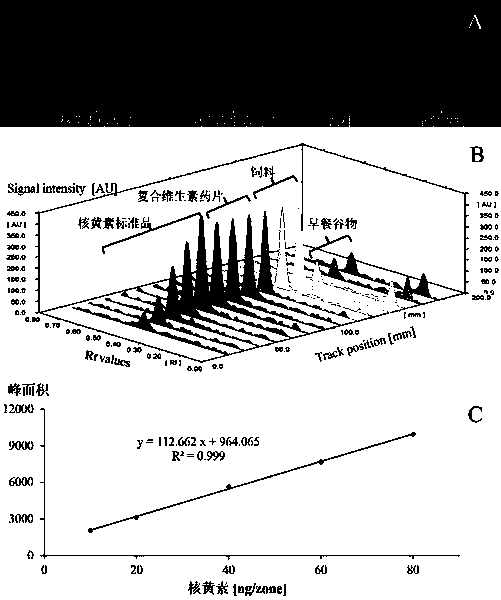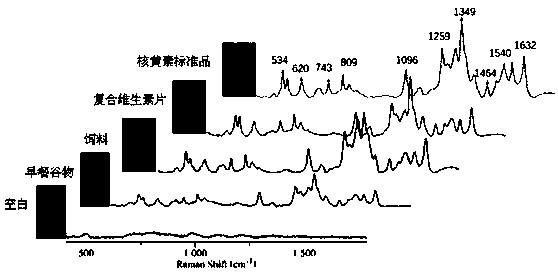Method for screening riboflavin in food and medicine by connecting high-performance thin-layer chromatography with surface-enhanced Raman spectrum
A high-efficiency thin-layer chromatography and surface-enhanced Raman technology, which is applied in the direction of measuring devices, instruments, scientific instruments, etc., can solve problems such as unsuitable for screening a large number of samples, high processing requirements, and instrument damage
- Summary
- Abstract
- Description
- Claims
- Application Information
AI Technical Summary
Problems solved by technology
Method used
Image
Examples
Embodiment 1
[0022] (1) Preparation of riboflavin standard solution: Use ammonia water with a mass concentration of 1% as a solvent, dilute with methanol to prepare a riboflavin standard solution with a concentration of 0.01mg / mL;
[0023] (2) Preparation of nano-silver colloid: silver colloid was prepared according to the classic method of synthesizing nano-silver colloid with sodium borohydride as reducing agent. Take 5mL of the original silver colloid and centrifuge (4000r / min, 10min), discard 4.5mL of the supernatant, place 0.5mL of the remaining liquid on a mixer and shake it for 1min to resuspend it, and obtain a 10-fold concentrated nano Silver colloid.
[0024] (3) High-efficiency thin-layer chromatography separation: 2-8μL riboflavin standard solution is accurately spotted with Linomat 5, and after sample spotting is completed, use a developing solution (methanol / ethyl acetate / triethylamine / water=2 / 8 / 1.5 / 1 (v / v)) to expand, expand 60 mm upwards, take out the silica gel plate ...
Embodiment 2
[0029] Riboflavin in multivitamin tablets, breakfast cereals and feed was tested separately.
[0030] (1) Pretreatment of multivitamin tablets: Grind the tablet into powder, weigh 0.5 g and dissolve it in 10 mL of 1% ammonia water, take it out after ultrasonication for 20 min, centrifuge at 3500 r / min for 10 min, pass through a 0.45 μm water film to obtain the tablet Samples were refrigerated at 4°C.
[0031] Pretreatment of breakfast cereals: Grind the cereals separately, weigh 2.5 g, add 10 mL of 0.1 mol / L hydrochloric acid, and heat in an autoclave at 121 °C for 15 min. Take it out and cool it to room temperature, adjust the pH to 6.8-7.2 with 1 mol / L sodium hydroxide, add 1 mL of peak amylase and place it at 37°C for 4 h. After finishing, dilute to 50 mL with methanol. After centrifugation, the supernatant was passed through a membrane to obtain a grain sample, which was refrigerated at 4°C.
[0032] Feed pretreatment is the same as breakfast cereals.
[0033] (2) Thin...
PUM
 Login to View More
Login to View More Abstract
Description
Claims
Application Information
 Login to View More
Login to View More - R&D Engineer
- R&D Manager
- IP Professional
- Industry Leading Data Capabilities
- Powerful AI technology
- Patent DNA Extraction
Browse by: Latest US Patents, China's latest patents, Technical Efficacy Thesaurus, Application Domain, Technology Topic, Popular Technical Reports.
© 2024 PatSnap. All rights reserved.Legal|Privacy policy|Modern Slavery Act Transparency Statement|Sitemap|About US| Contact US: help@patsnap.com









